As we all know, companies often provide their own view on performance measures which not rarely differ quite a lot from IFRS measures. In some cases this choice of measure is due to the idea of managing and allowing to analyse the company in a better way (good reason), in other cases it is rather for generating some flexibility in investor communication (bad reason, see https://valuesque.com/doms-underlying-earnings-definition-the-profit-before-cost-financial-analysis-problem/).
And if it is not about IFRS numbers but rather about some non-GAAP standard financial measure – such as the Free Cash Flow – then variation seems to be even more delectable for companies. This has been the case now for a long time with companies sometimes including interest pay-outs into their Free Cash Flow calculations and sometimes not. But the introduction of IFRS 16 now aggravates the relevance of this topic further. What we can see from first experiences is a motley FCF-calculation-hodgepodge – with Amadeus IT Group S.A. clearly leading the pack in terms of audacity.
To be honest: there is no one hard definition for Free Cash Flow. But there are of course some rules of consistency, or put differently: some rules on how Free Cash Flow must be calculated if you want to make a certain statement. For business valuation reasons, for example, there is an absolute clear relationship between the free cash flow definition, the cost of capital definition and the dimension of the enterprise value (for more information with regard to IFRS 16 see: https://valuesque.com/deutsche-post-more-debt-same-equity-value-the-ifrs-16-financial-analysis-problem-part-1/). Similar is the case for credit analysis or for leveraged-buy-out (LBO) models.
Companies, however, do not have to care about consistency. They can define the free cash flow as they want or as it best fits to their management needs (if they define it at all), with the question of inclusion or non-inclusion of financial charges being the main – but not the only – point of differentiation. And investors have to live with this communication non-uniformity.
The introduction of IFRS 16 (Lease Accounting, see the Deutsche-Post-link above for more information) has now brought new challenges to companies’ Free Cash Flow calculations with regard to former IAS 17 operating lease payments. This is the case as while annual lease payments had been clearly seen as an operating cash component under the old IAS 17, they are now split into a lease liability repayment and an interest expense on the lease liability – both of which rather sound like financial components at first glance. But should this accounting-only change really impact the way how companies look at the Free Cash Flow? In particular as their choice of Free Cash Flow definition should have had purely economic drivers in an ideal world (again: no IFRS standard forced them to go this way)?
For answering these questions we have a look at a small selection of real world examples of how companies deal with this issue. This sample is non-exhaustive, it is put together based on typical outcome scenarios – there are for most of the scenarios many more companies around who behave the same way. As we will see, there are some no-changers, some soft-changers and also some soldiers of fortune.
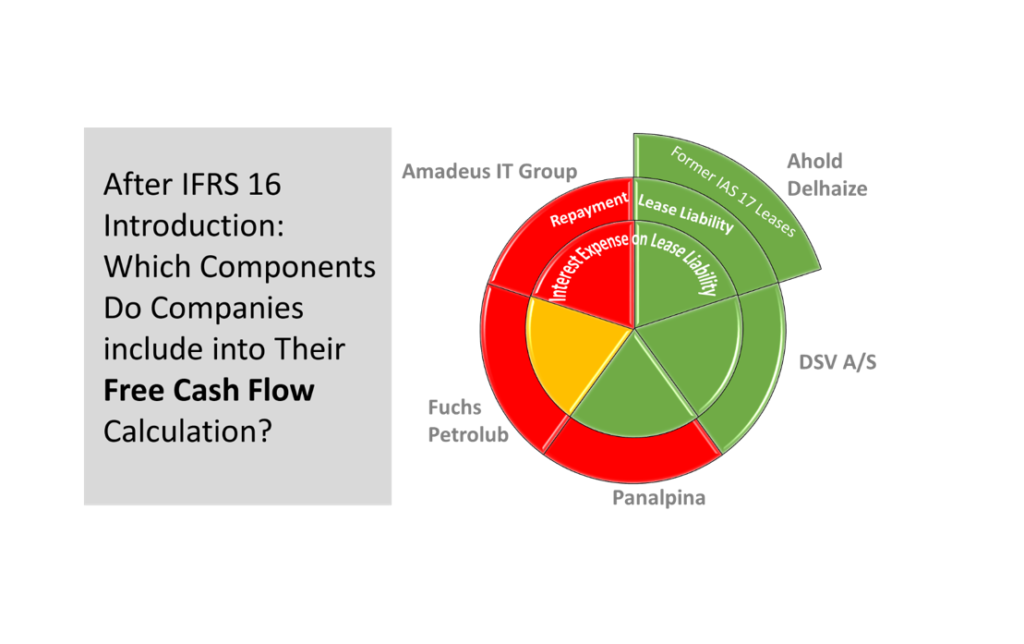
The biggest positive surprise in our sample was Ahold Delhaize. The company did not only announce to include all former operating lease payments into the Free Cash Flow calculation (i.e. making the new lease liability interest expenses and the lease liability repayments being part of the Free Cash Flow) they also freshly included the old IAS 17 financial lease payments – which were not included so far – into their calculation grid. This makes sense from both a consistency and an economic point of view – even at the cost of a now lower disclosed Free Cash Flow.
The rational economic IFRS 16 adopter in our sample is logistics group DSV. They didn’t change anything in their economic view on Free Cash Flows. They simply counter the fact that lease payments are now treated differently from an accounting point of view with a little adjustment in their Free Cash Flow calculation. A very smart and subtle way.
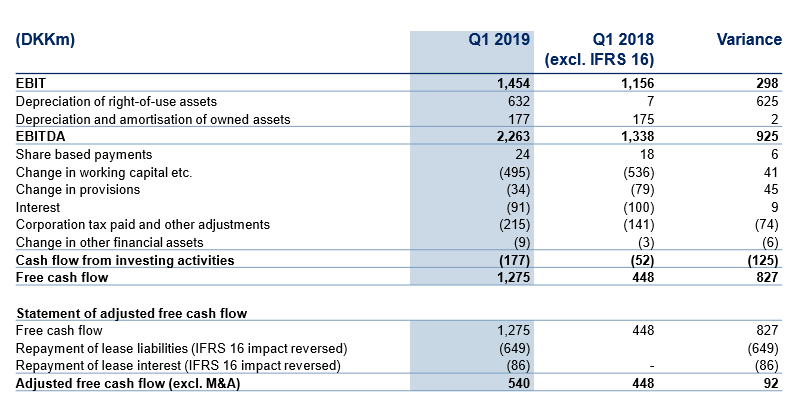
The award for the dogmatic adopter goes to another logistics giant (and future partner of DSV): Panalpina Welttransport Holding AG. The company sticks to their original calculation grid – whatever happens. And when the standard setters want to reclassify some items, then they simply show up in a new place in their calculation grid. Part of the lease payments is now debt repayment (i.e. financial)? Then it no longer feeds into the Panalpina Free Cash Flow calculation. This is the easy way to deal with this topic, but it does not represent a highly economic view on things.
Similar to Panalpina, but a with some uncertainties on how it will be concretely applied in practice is Fuchs Petrolub SE. The company commented in the 20 March 2019 Financial Year 2018 results conference call on the development of the 2019 Free Cash Flow (information taken from the transcript provided by Thomson Reuters Streetevents) that “…there is very minor special effect out of the accounting for this IFRS 16 leasing standard, which will give us, I don’t know, €8 million or €7 million higher free cash flow…”. But it is not possible to see where exactly these numbers come from. Is it only the reclassification of the lease liability repayments or also some interest expenses on the lease liability? From the pure numbers (rental and lease payments totaled €18 million in 2018, but Fuchs Petrolub also stated that they will make use of exemptions for short-term leases and leases for low-value assets in their new IFRS 16 accounting) no inference is possible. Here we have to wait and see what the concrete outcome will be.
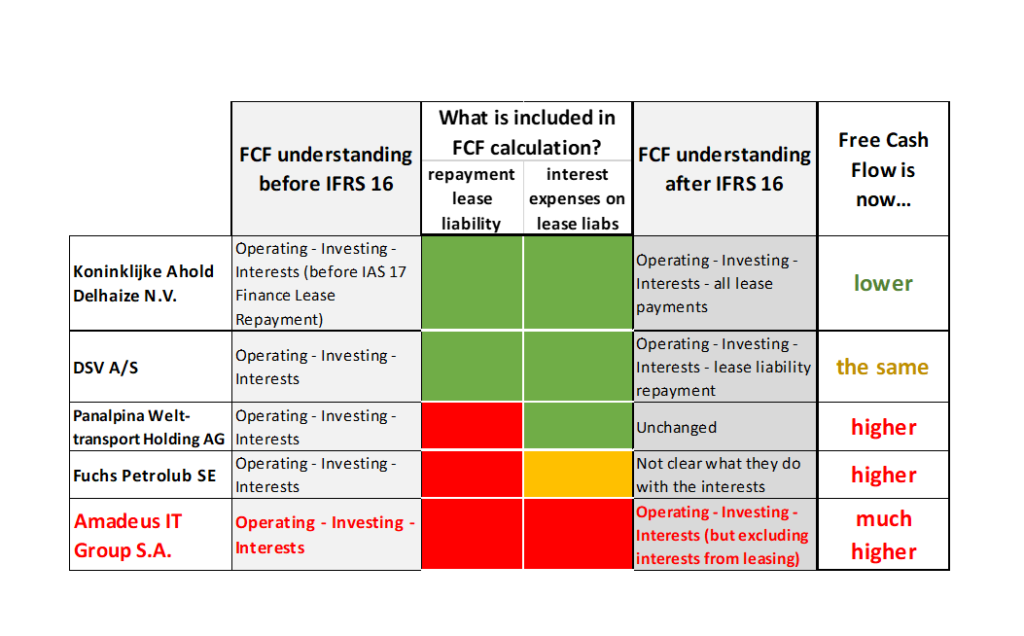
And finally, the award for the soldier of fortune goes to Amadeus IT Group S.A. This 2018 early-adopter company made use of the IFRS 16 accounting change to seemingly hide away roughly €4.9 million of lease interest payments (about 42% of its IFRS 16 adjusted Free Cash Flow growth in 2018) from its Free Cash Flow calculation – all this without a single clear comment on it in the 2018 reports! Let’s have a closer look below on how they did it.
First, some more information on the IFRS 16 impact on Amadeus balance sheet and P&L is necessary. The company follows a Modified Retrospective Approach, meaning that it does not have to restate its earlier years’ accounts (more information on the different transformation approaches: https://valuesque.com/shells-skyrocketing-discount-rates-the-ifrs-16-financial-analysis-problem-part-2/).
Their disclosed Free Cash Flow number is further defined after paid interest charges:

Amadeus now states that IFRS 16 drove upward EBITDA by €47.4 million, and simultaneously interest expenses also upward by €4.9 million. This means (assuming this is all cash-relevant) that the new accounting outflow from debt repayment should amount to 47.4 – 4.9 = € 42.5 million. So far, so unspectacular. However, only some lines below this comment, Amadeus states that there was a debt repayment of €47.4 million due to IFRS 16 – the same amount as the EBITDA increase. This should now – according to Amadeus – balance the cash effects.
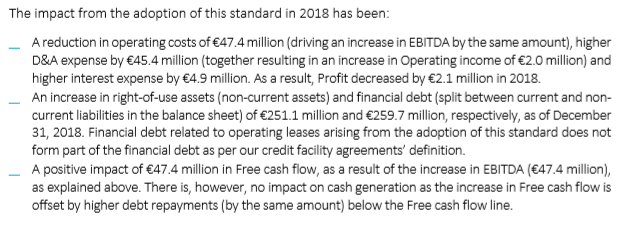
But how is this possible? This debt repayment number differs from my calculation exactly by €4.9 million (the same as the interest expense). Some further investigation is obviously necessary. Below is a short version of the 2018 Cash Flow Statement of Amadeus.
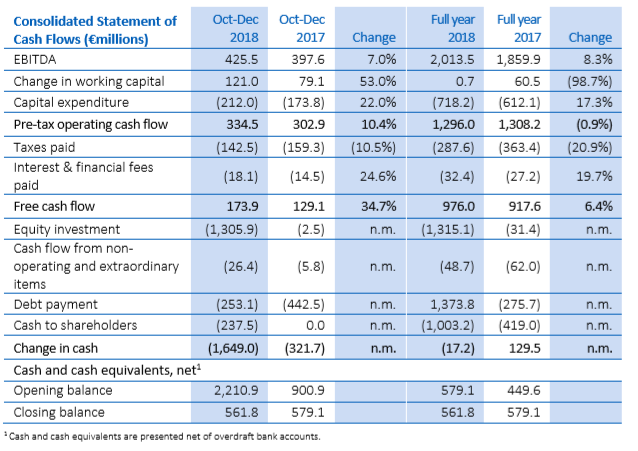
The relevant number is here the Full Year 2018 Free Cash Flow (€976 million) and the way how the company determined it. We checked every position, in particular the EBITDA of €2,013.5 million (here is no interest expense included, as already stated by the company above [Amadeus splits the IFRS-16-effect in the P&L into an EBITDA impact and an interest expense impact]) and the Interest & financial fees paid (here is also no IFRS 16 interest impact included, see table below [the €5.3 million difference would have been commented differently if this position was included]).

So, where is the interest expense? There are basically only two explanations for it:
- The highly probable explanation: The lease interest expenses are part of the obscure “Debt payment” position (€1,373.8 million) below the Free Cash Flow Calculation in the short Cash Flow Statement. Unfortunately, it is not possible to retrace this number from the information given in the long IFRS Cash Flow Statement. But if the interest expense is really hidden there then also the comment on the balancing of the €47.4 million EBITDA increase by the “debt repayments” stated in the IFRS-16-impact-comments above would make sense (take care of the different wording in the comment and the table: payment vs. repayment!). I also checked the “Cash flow from non-operating and extraordinary items” position but could not find any indication that the interest expenses are part of it.
- The highly improbable explanation: There was a non-cash component to the 2018 operating lease expenses exactly by the same amount of the accounting interest expense. But what a coincidence this would be? Why should there be a non-cash component? And then incidentally exactly by this amount? I highly doubt that this is the case. And I couldn’t find any indication in the lease asset valuation that this should be the case.
So it clearly seems as if Amadeus has hidden the €4.9 million lease interest expense within the debt repayments (where it definitely does not belong to). As the company normally determines the Free Cash Flow after cash financial interest charges, the financial charges from the lease liability are now excluded! The potential argument that this expense is not a cash interest outflow to a third-party because Amadeus does not pay interests to the lessor but only contractual lease payments would not make any sense neither: It is a cash outflow, and it belongs to the normal Free Cash Flow calculation grid of Amadeus, however you look at it.
So what? Free Cash Flow is not an IFRS measure. Amadeus can state it as it wants. But (1) the proceeding does not follow any logic, and (2) Amadeus could have made clear in the Annual Report that it follows this strange differentiation of non-lease interest expenses and lease interest expenses. They didn’t do it [presumably because they didn’t want to get some uncomfortable questions from investors] and by this they managed to improve the Free Cash Flow by €4.9 million – not much in absolute terms but a lot in terms of year-on-year change (more than 40% of the IFRS-16-adjusted Free Cash Flow difference as compared to 2017).
For investors such proceeding (or at least the suspicion of it) should raise some more questions. E.g. the Amadeus management remuneration is linked to the pre-tax adjusted free cash flow (see below), a measure which is admittedly not impacted by this obscure interest expense classification, but perhaps impacted by the IFRS-16-change per se. So it would be very interesting to know what this “adjusted” really means in practice. Is the one-time-IFRS-16-accounting effect from the higher EBITDA here subject to an adjustment or not? Me as an investor, I would be highly interested if a company that follow such non-transparent proceedings with regard to the whole Free Cash Flow also follows similar procedures with the remuneration-relevant part of the cash flow. But I have no answer on it yet.
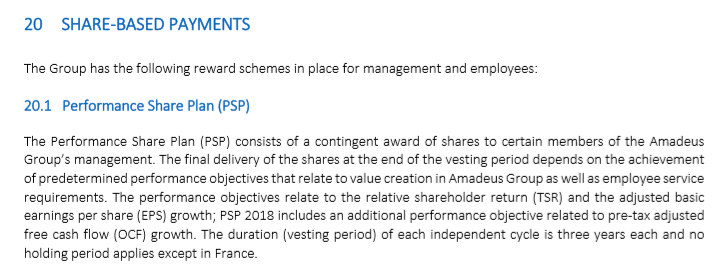
As always, it might be that I didn’t get everything right (then I would be very happy to learn about the true nature of the Amadeus’ dealing with the lease interest expenses), and of course this is not an investment recommendation but only my subjective analytical result. But whether I am right or wrong, there are definitely some lessons to be learned from all these cases discussed above in this article:
- Don’t set much store by companies’ Free Cash Flow definitions. Some companies state it before, some after interest expenses. Sometimes some specific operating expenses are excluded, sometimes not. In the course of the IFRS 16 adoption some companies change their view, others not. It might be that the stated measure is helpful for managing the company, it might be that it is only for investor impression reasons. Whatever it is: Use your own Free Cash Flow definition. It must fit to your valuation model. But discussing the reasons for the particular Free Cash Flow definition with the management – and learning from this – is always a good approach. This is the only reasonable way of dealing with this non-GAAP measure provided by companies.
- Take care if Free Cash Flow (or other non-GAAP measures) are the basis of management remuneration schemes. Then we can (and we have to) learn a lot on how management has an impact on performance measurement and on how it is incentivised to do a good job.
- Similar to the last point, the introduction of IFRS 16 is a very interesting case of looking deeper into management’s general philosophy. We have an accounting shift from operating to financial. And we can take a lot of information out of this shift and management’s reactions thereof on how the company is run in its very basic and categorical terms.

